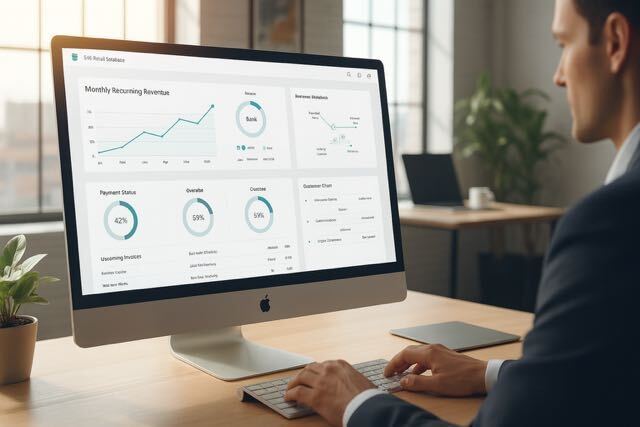Building a Partner Ecosystem Strategy with Avanish Sahai

Channel partnerships are a growth opportunity for B2B SaaS companies to build sales and revenue. But building them often comes with a fear of diminishing margins and lowered productivity that can quickly sideline the idea. You can exponentially accelerate your company’s sales growth with the right approach to building channel partnerships.
But how do you get started?
In this webinar, industry expert Avanish Sahai shares a decade’s worth of experience (across companies such as HubSpot, Google, Salesforce, and ServiceNow), on how B2B SaaS companies can pursue channel partnerships.
Avanish needs no introduction to an audience of partnership folks. He has been a mentor to Zomentum from day zero. He currently serves on the board of HubSpot. Previously, he's been credited with building the partnerships ecosystem at Salesforce, ServiceNow, Google, and Demandbase.
In this blog, inspired by the webinar ‘Accelerate Sales with Channel Partnerships’, Avanish shares learnings from his decade-long experience working in the partnership ecosystem.
Partnerships in the GTM Landscape
Avanish has seen the evolution of channel ecosystems from the mainframe era to today in the cloud era. But what does he think about today's GTM landscape and where partnerships come into the picture?
According to Avanish, there is a big change in how investors, operators, etc., think about go-to-market. He joined Salesforce in '09, and in '09, frankly, Salesforce was a bit less than a billion dollars. They barely had any kind of partner ecosystem. They did the selling and marketing on our own. They had some integrations but did not have a SI or GSI network. But as time evolved, the Salesforce economy now has numbers at over $1 trillion. Salesforce partners have greatly contributed to that experience and drive more value to their customers. Salesforce partners are a mix of technology partners, ISEs, resell partners, MSPs, SIs, GSIs, etc.
The world has changed a lot when it comes to the spectrum of channel relationships and channel partnerships. Salesforce was probably a bit early in helping define that. But since then, it takes a bit of a different flavor in the cloud or SaaS offerings.
You have to have a tight coupling. You can't dissociate yourself as you did in the old days. The GTM today has very tight relationships.
Welcome to the Decade of Partner Ecosystem
There are a lot of articles from pretty respected analysts like Jay McLean from Canalys saying that this is the decade of the ecosystem. In this ecosystem are tech partners, strategic partners, SIs, GSIs, resellers, and MSPs, you name them.
But why is this the decade of the Partner ecosystem? Here are three reasons
- You can scale in a non-linear fashion. Businesses can build a broader ecosystem without making the investment, headcount, and sales just by bringing partners who understand the landscape. Partners would have the right kind of people already in place, and in exchange for a certain percentage, they're bringing vendors into places where they don't have to make their investments.
- Partners have relationships. These incumbent relationships, from service providers, SIs, and GSIs, are worth a lot. They're not going away. Think about leveraging them instead of disrupting them.
- There is an opportunity to enter new markets through a reseller channel or a set of boutique service providers. Partners open doors that otherwise would be much harder for vendors to open.
Partnerships are no longer an afterthought.
In today's climate, if you look at the number of companies with a partner program or a partner-first strategy, it's almost often an afterthought. But partnerships are not an experiment. It’s not - let's try something. Not a big deal. Partnerships are becoming core to the ecosystem strategy. It involves product, marketing, sales, customer success, and a partnership team.
You will fail if you try to do all those things at once. You have to think about prioritization and challenges and, from there, figure out which relationships you need to invest in first versus which ones you can create a plan for later.
Building the Best-in-Class Partner Management Team
It's a broad team effort to build the partner management team. The key is to figure out the right mix of skills and backgrounds and how you help them succeed. When building a partner management team, think about these three objectives:
Think about Team Building from a Whole Solution Perspective
Do not think about it as a silo - in terms of individual objectives and targets. Partnerships are about aligning the ecosystem strategy across product, marketing, sales, and customer success. If you want to be successful in this function, you have to be cross-functional.
Empathize with your Partners
If you’re going to work with a GSI such as Accenture, Deloitte, KPMG, EY, Infosys, or TCS, they are no longer playing themselves as a single function. They are also building products. They're reselling. They're also an MSP. So a good partner leader would look at it from an internal point of view, aligned across all the functions. They would also look at it from the GSI point of view to see how they're pursuing, building, or managing. So the person who will be successful in this kind of role has to switch those hats and put themselves in the prospective partner's shoes.
Partnerships should be Measurable
It's no longer sufficient just to say, - I did the partnership, I signed the agreement, someone else's problem. Now, it is a continuous effort. Most SaaS or cloud businesses are measured not just on what they sell but on renewals, customer success, and NPS. These metrics didn't exist 20 years ago. 20 years ago, you just sold. You moved on. Now, you have to sell. Come back. Make sure they're getting value, are ready to renew, and renewals happen with growth. Partner-led opportunities, or partner-led deals, have a higher ACV. They are retained for longer. There is more value for the end clients.
The Economics of Partnerships in GTM Landscape
If you're building the partner ecosystem, the economics of different types of relationships would be different. The reseller economics will differ from MSP economics, which may differ from ISV/tech partner economics.
The leadership function of the partner team has to be aligned with finance. You also need a business plan. Your strategy shouldn’t be just about the three logos you have. But also about - What are you going to do with them? What does a joint business plan look like with those relationships? A business plan will have a top-line element: how many deals, the kind of deals, and the economics.
You have to look at it holistically - what does the overall business look like with that partner? You should look at this from a three-year, maybe even five-year perspective. What does that business plan look like? What is in it for the partner? What are those different motions, and when do those kick in? Not everything is going to kick in from day one. And then the partnership economics became very clear.
For example, let's say you're a mid-sized vendor with interest from a global SI. Well, they're going to invest. You're going to invest. They want a $100 million business in 2-3 years. To reach $100 million, you need to ask yourself what the economics of each category of service lines, the MSP business, and the IP productization business are. That becomes your framework.
It's a comprehensive approach that must be taken to understand the economics and ensure the right commitment across all the different sides to get there.
Building Metrics for Partnership Teams
Another common question most partnership leaders ask is the leadership's expectations when carving out these budgets for partnership teams. What should they measure when balancing revenue and long-term growth?
In many organizations, a CFO or a CRO may look at budgets for partnerships and say - should I put ten people in sales or ten in partnerships?
Those ten people can be productive between 90 and 180 days in sales, generating x per head with some ramp. There is a clear sense of what outcomes you can get by segment, experience, and tenure.
In the partnership space, the metrics are still fuzzy.
To overcome this, you must make sure decisions don’t happen just on the C-suite level. It has to happen at the board level. It has to happen across the organization, which gives non-linear growth.
There should be alignment across the board. Otherwise, it gets really hard to make people believe you. How you convince them is by borrowing examples from others. Compare the growth achieved in company A versus B versus C and the fundamental beliefs when these companies started. Prepare a plan on how these companies helped the rest of the organization align and how the business evolved. This storytelling and getting the belief among your peers and the rest of the organization is a long game.
So if you say you’re putting a partnership team in place in June and expecting to see top-line results by December, it isn’t going to work. You have to build a relationship. You have to enable them. You have to drive the joint business planning. This is a fundamental belief that this will pay off in the long - medium term.
Read Next: Five-Point Checklist for Developing a Partner Enablement Strategy
Number two, be careful about how you measure your partner's journey. Think in the long run. If you devise a plan to have five different classes of partners going off the ground in the next six months - it will not happen. A more realistic example would be if - You’re going to pursue two-three GSI, one or two important countries. You’ll identify one or two resellers and not involve tech or ISVs because you need investments in the product. Having that level of clarity on the sequencing and the metrics is important.
Once you have the crawl phase, the walk phase will be putting together a set of target count lists filtered by geography, industry, relevance, etc., which will become a pretty specific set of joint targets. And that will take x number of quarters or months to align around. By year 2, you will close 20 of the accounts we identified. You'll be in POCs in 3 of them and may have a deal with 2 of them.
That's the level of granularity that has to be put in place. It won’t be perfect, but it should give everybody the confidence that, by taking these actions and engaging in that kind of relationship, you can get into accounts and customers that, otherwise, would be a lot harder to get into.
Mistakes To Avoid Building Partner Ecosystem Strategy
Don’t spread yourself too thin by going on an acquisition rampage but not nearly engaging your partners as much. You try to do too many things at the same time with not enough capacity and not enough resources, and then you find that your partners are getting frustrated and they're not executing. And then your customers are not getting what they need.
The second mistake is not spending enough time aligning internally. Do more of that upfront. Make sure you get all the people who may not either understand it or believe it, spending time with them and making sure that they're fully on board is,
The third mistake is not being metrics-driven. It's fundamental because the rest of the organization is being metrics driven. Much hard data drives decision-making, resource allocation, prioritization, etc. That same rigor, insight, and scrutiny must also apply to the partner organization.
These are the three big areas to focus on. None of them is easy but helps build credibility and success.
Strategy for Partners Interested or Already Selling to Competitors
You have to be a better product. You have to be in a better relationship. Your partners must want to work with you rather than your competition. So look at that as an opportunity, which forces you to say, why would that partner and, ultimately, the customer choose me plus that partner rather than a partner plus a competitor?
There are a lot of variables. It could be because you have a better product or overall experience, or you’re more empathetic, or the economics work out better. There's no single answer, but it's figuring out why either their sales or delivery team will choose to work with you over the competitors. And just like any customer can choose you or any of your competitors, that partner has a choice, too. You have to make it worth their while.
That's something that Zomentum has recognized from day 0 as well. If you see the Zomentum marketplace, partners get to choose different vendors they can work with, and in each category, multiple vendors could provide different solutions. But the difference is, when the A plus partner and the B plus partners are on the same things, it's about relationships and how we go to market together.
Impact of the Disruption by Marketplaces like GCP, AWS, and Azure
There is a big change happening, particularly with the cloud vendors. The big infrastructure vendors, AWS, Azure, and GCP, have built substantial businesses. The numbers are staggering. GCP went from a $4 billion to a $26 billion run rate in about four years. Across all its cloud businesses, Microsoft is approaching $60 - $70 billion. And AWS may be approaching $100 billion. These are big numbers.
Now, underlying those numbers are the fact that they're doing massive deals with end customers, where the proposition is - Vendors (AWS, GCP, and Microsoft) are going to help you migrate a big part of your workload from on-prem and older technology stacks to modern cloud-based infrastructure and stacks. In that deal construct, what they are doing is they're requesting the customer to make a 3 or 5, or 10-year commitment that says, from an infrastructure perspective, which is computed, storage, networking, egress, and ingress costs of data here's how we're going to model your transition from current to future. And that only converts into revenue once that customer deploys applications and consumes the committed infrastructure.
So with these megadeals happening from the infrastructure vendors, they're now collectively using their marketplaces to expose the end customer to partner solutions that are available in the marketplace, where they can be discovered, transacted, and deployed seamlessly. Once they transact on the marketplace, that helps the end customer burn down commits. So those big commits they made, they can now use ISV third-party solutions to burn those down. That has taken off as wildfire because it now makes it economically important, operationally, and from a deployment perspective.
So the projections are that these marketplaces are going to grow dramatically. According to some experts, 60% - 70% of core enterprise buying for software may happen through marketplaces five years from now. That's staggering, and there are a lot of services that those marketplaces are offering a repeated offer that help made that experience very seamless. So it's a big part of the future.
Understanding which infrastructure vendors matter to your business and your joint customer base, figuring out what those relationships need to look like, and determining the economics. Those are important decisions to make as part of the mix, including marketplaces in a mix of different channel relationships, but it's certainly one of them.
When should you start a Channel Partner Program
There isn’t a single answer to this.
So let’s take examples.
You must prove product-market fit if you're an early-stage venture-backed company.
So for the early customers (to series A and maybe even a part of series B), the customer relationship is supercritical. You have to understand their real problems and if you’re solving them well. Figure out their experience working with you from an engagement, deployment, configuration, and services perspective.
However, if you're later stage, then discuss what the knobs are that a partner ecosystem can help me either accelerate or reduce my acquisition cost or sale cost. Think about that in a very thoughtful, prioritized, strategic matter. When you start getting to Series C and hitting $50, $75, and $100 million in AR and want to think about scale, it’s the right time to start partnerships.
Secondly, your product should be ready to build a partner ecosystem. For example, for an ISV relationship, ask yourself these questions:
- Do you have the APIs?
- Do you have documentation?
- Are you ready to support an end customer and a software company that will probably be more demanding about how you expose the APIs?
- How do you manage security?
- How do you manage performance?
- Do you have SLAs?
- Do you have a contract that allows them to operate?
These questions are not just for the partner manager; the product organization has to be equally invested in it and committed to it.
Building a partner ecosystem is becoming part of a strategic set of decisions that must be thought through and the investments needed to make it happen.
Build Your Partner Ecosystem with Zomentum
Zomentum is a revenue platform for SaaS partnership teams to build their core sales motions and drive revenue with partners. If you can relate to poor partner portal options, not getting visibility into the partner pipeline, or just want to proactively co-sell with partners, Zomentum is your place.
If you want to discuss your partner programs, give us a shout. More than happy to take those conversations.





.png)









